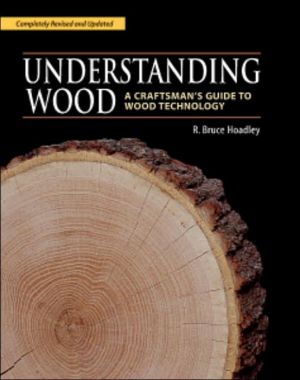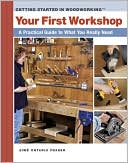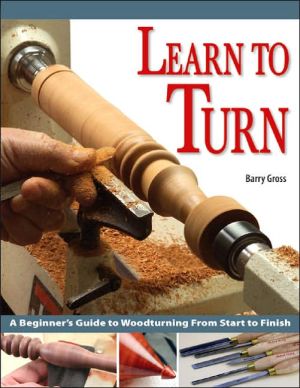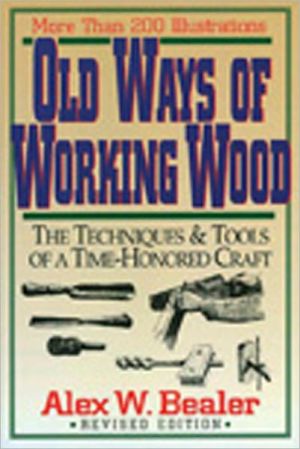Understanding Wood: A Craftsman's Guide to Wood Technology
In this essential reference for woodworkers, R. Bruce Hoadley explains everything from how trees grow to how best to cut, season, machine, join, bend, and finish wood. Why do miters open and glue joints loosen? How do you get a really sharp edge? Examples of problems and solutions help woodworkers puzzle through their own projects, while full-color photos and helpful tables illustrate key points.
Search in google:
Inn this essential reference for woodworkers, the author explains everything from how trees grow to getting a sharp edge. Includes examples of problems and their solutions to help woodworkers through their own projects. Full-color photos and b&w illustrations. Library Journal Wood is a complex, dynamic material that can only be used successfully if the craftsperson understands it. It reacts to changes in humidity, and the various species have widely different working and structural properties (in addition to their many colors and textures). Both Hoadley and Peters do a good job of helping readers understand the factors that must be considered when using wood and products such as plywood. A frequent writer on home improvement topics, Peters offers a colorful book geared toward hobbyist woodworkers. He covers the process of making lumber from start to finish, including how trees grow, their structure, common ways of milling and drying lumber, grading, and possible defects found in wood. One section shows wood samples (both finished and plain) and describes their basic working characteristics. This particularly attractive book is filled with colorful photographs and illustrations and includes both a glossary and an excellent appendix showing the hazards posed by the sawdust of specific wood species. Hoadley, a professor of wood science and technology, has revised his classic title for its 20th anniversary. While the original is still great, the new title incorporates the latest technologies in adhesives, finishes, and wood products. Color photographs are a welcome addition as the original edition's photos were drab and unappealing. Hoadley covers much of the material that Peters does but in far greater depth. While this complexity may intimidate beginners, it is just what advanced users and professionals need. For example, Hoadley's wood identification section consists of macrophotographs of wood samples magnified ten times so that the correct species can bedetermined from the pattern of wood cells. This title also includes an in-depth glossary, bibliography, and index. Hoadley's work is an improvement of a classic while Peters's is good enough that it will likely stand the test of time as well. The difference is in complexity, not quality. General public library collections will get more use from Peters's title, while in-depth public and academic libraries will want Hoadley. Jonathan Hershey, Akron-Summit Cty. P.L., OH Copyright 2000 Cahners Business Information.\\
\ Library JournalWood is a complex, dynamic material that can only be used successfully if the craftsperson understands it. It reacts to changes in humidity, and the various species have widely different working and structural properties (in addition to their many colors and textures). Both Hoadley and Peters do a good job of helping readers understand the factors that must be considered when using wood and products such as plywood. A frequent writer on home improvement topics, Peters offers a colorful book geared toward hobbyist woodworkers. He covers the process of making lumber from start to finish, including how trees grow, their structure, common ways of milling and drying lumber, grading, and possible defects found in wood. One section shows wood samples (both finished and plain) and describes their basic working characteristics. This particularly attractive book is filled with colorful photographs and illustrations and includes both a glossary and an excellent appendix showing the hazards posed by the sawdust of specific wood species. Hoadley, a professor of wood science and technology, has revised his classic title for its 20th anniversary. While the original is still great, the new title incorporates the latest technologies in adhesives, finishes, and wood products. Color photographs are a welcome addition as the original edition's photos were drab and unappealing. Hoadley covers much of the material that Peters does but in far greater depth. While this complexity may intimidate beginners, it is just what advanced users and professionals need. For example, Hoadley's wood identification section consists of macrophotographs of wood samples magnified ten times so that the correct species can bedetermined from the pattern of wood cells. This title also includes an in-depth glossary, bibliography, and index. Hoadley's work is an improvement of a classic while Peters's is good enough that it will likely stand the test of time as well. The difference is in complexity, not quality. General public library collections will get more use from Peters's title, while in-depth public and academic libraries will want Hoadley. Jonathan Hershey, Akron-Summit Cty. P.L., OH Copyright 2000 Cahners Business Information.\\\ \








